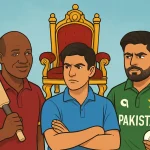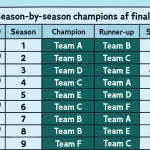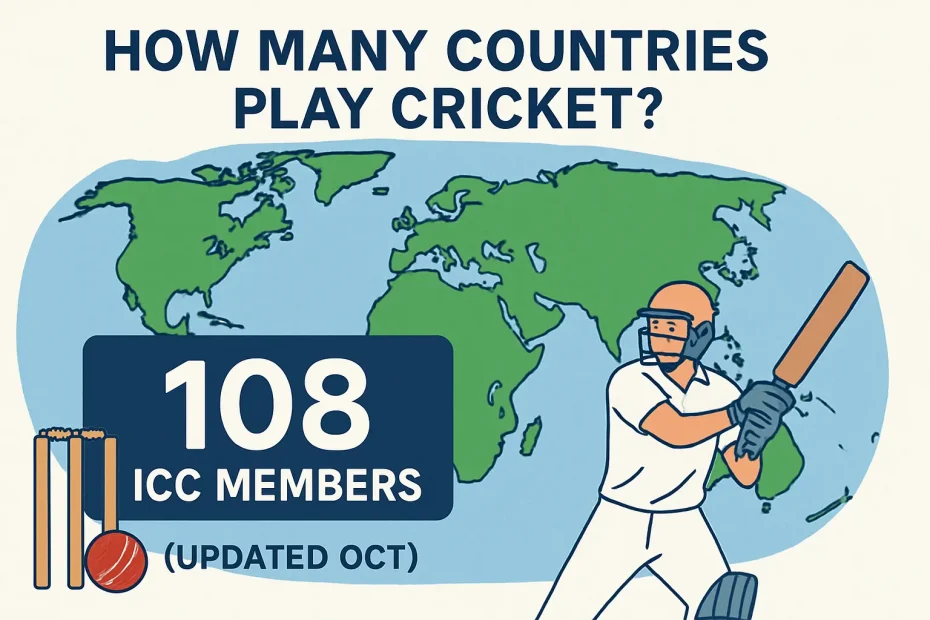Quick answer
As of this month, 108 countries are members of the International Cricket Council (ICC): 12 Full Members and 96 Associate Members. Source for verification: https://www.icc-cricket.com/about/members
Last updated: October
Full Members (Test-playing nations)
- Australia
- Bangladesh
- England
- India
- Ireland
- New Zealand
- Pakistan
- South Africa
- Sri Lanka
- West Indies
- Afghanistan
- Zimbabwe
What “play cricket” really means
Ask a fan in Guyana, a club scorer in Hamburg, or a junior coach in Kigali, and you’ll hear wildly different meanings for the phrase “cricket-playing country.” In the game’s official vocabulary, three layers matter:
- ICC membership: The definitive list. If a national governing body belongs to the ICC, that nation is part of international cricket’s formal family. Today that total is 108 members, split into 12 Full Members and 96 Associate Members.
- Eligibility to play official internationals: All ICC members are eligible to play Twenty20 Internationals (T20Is). That’s the ICC’s deliberate move to democratize the sport—give a short, accessible format global status so new and growing nations can step onto the same line on a scorecard as the giants.
- Reality on the field: Not every member has played an international match yet, and not every member plays every format. Some Associates compete mostly in regional T20s and age-group tournaments while building facilities and pathways. Others, like Scotland or the Netherlands, are fully professional programs that beat Full Members on any given day.
This distinction matters for a simple reason: when people ask how many countries play cricket, sometimes they mean “how many are ICC members,” sometimes they mean “how many have ever played a T20I,” and sometimes they mean “how many have Test status.” Those three numbers aren’t the same—and they tell different stories about where the game is and where it’s going.
Full vs Associate Members: What the labels actually mean
The headline split—12 Full, 96 Associate—isn’t about “real countries” versus “aspiring countries.” It’s about maturity of domestic structures and historical place in the game’s development. Practically, here’s what the difference looks like on the ground.
Full Members
- Test status and automatic ODI and T20I status for men; women’s teams play ODIs and T20Is as determined by ICC competitions and ranking structures.
- Direct access to top-tier ICC events and pathways, plus larger revenue shares from ICC distributions.
- Scheduling power within the men’s and women’s Future Tours Programme, enabling regular bilateral series that build broadcast value and player pipelines.
Associate Members
- All Associates have T20I status for men and women.
- ODI status is selectively granted to top Associates for a competition cycle based on performance in ICC pathways.
- Funding from the ICC is tiered, tied to audited governance standards, participation numbers, and competitive results.
- A heavy diet of regional play, global qualifiers, and high-performance support—think academies, coaching exchanges, and facility grants.
None of that stops an Associate from beating a Full Member. It happens regularly in T20Is, and more often than some chairpersons care to admit. The gap is narrowing in formats that compress variance and reward clear plans and sharp fielding.
List of ICC Full Members (with context only an obsessive notices)
- Australia:
- The high-performance machine. Sheffield Shield tempo crafts Test athletes who bat time and bowl relentlessly. Women’s domestic structures set the global benchmark, and the WACA’s wind will teach you more about angles than any textbook.
- Bangladesh:
- A cauldron at home. Dhaka spin, Chattogram batting tracks, and a fan culture that swings results. Age-group talent never stops bubbling; it’s the senior execution that determines cycles.
- England:
- Tradition and reinvention. From Lord’s protocols to the white‑ball revolution, the English game thrives on its county backbone and a willingness to rip up plans when the data demands it.
- India:
- Depth on depth. A talent base so large that an “A” tour can look like an international side. Domestic T20 and top-flight women’s leagues turbocharge development and scouting like nowhere else.
- Ireland:
- Crafty competitors. Green seam in early season, lots of allrounders, and a habit of making better-resourced teams uncomfortable, especially in events where tactical sharpness beats raw power.
- New Zealand:
- Lean, clever, and centered on culture. Smaller player base, world-class pathways. They weaponize clarity: simple plans executed with discipline and a quiet ruthlessness.
- Pakistan:
- Pure fast‑bowling DNA. Talent blooms in the alleys as much as in academies. When the rhythm clicks, their attack can take twenty wickets on tracks others call docile.
- South Africa:
- Athletes everywhere. Schools cricket feeds a relentless conveyor belt of pace and fielding standards that make one-run saves feel routine.
- Sri Lanka:
- Wristy flair and cricketing intelligence. From the art of late cut to the guile of mystery spin, Sri Lankan cricket is steeped in invention.
- West Indies:
- Power with heritage. The Caribbean brings unmatched aura; the T20 circuit is both challenge and strength, stitching together a regional identity through franchise calendars.
- Afghanistan:
- The rise of leg-spin and fearless hitting. From refugee camps to Test status, their story reshaped the global map. Spin factories, raw pace, and a street-smart approach define the brand.
- Zimbabwe:
- Proud survivors. Structures have been through storms, but the talent keeps coming. At their best, they scrap hard, especially on slower tracks where smarts trump muscle.
How many countries play international cricket in each format
The short-format revolution changed everything. T20I status now applies to every ICC member, which means 108 national teams are eligible to play official men’s and women’s T20 internationals. That single decision pulled dozens of emerging federations into the global results book, making a debut feel real in a way that regional friendlies never did.
The nuance: eligibility versus participation. Not every eligible team has played yet. On the men’s side, well over ninety national teams have already appeared in official T20Is. On the women’s side, the number continues to climb steadily as federations build squads and schedules. New debuts tend to come in regional subqualifiers or during bilateral windows supported by ICC development programs. It’s normal to see two or three new flags pop up on cricket’s T20I map every season.
ODIs are tighter by design. Full Members automatically play ODIs; select Associates gain ODI status for a cycle via performance in the ICC’s League 2 and qualifying structures. The precise list can change when a cycle turns over. Associates such as the Netherlands, Scotland, Nepal, UAE, Namibia, Oman, United States, and Canada have held ODI status in recent seasons, while others cycle in with promotion. If you’re checking this for a betting preview or broadcast note, verify the current ODI-status list on the ICC site before filing copy.
Tests remain the elite preserve of Full Members. That’s tradition and also practicality—red ball requires a multi-day domestic culture, long first-class seasons, and the infrastructure to keep players in that rhythm. The travel and broadcast economics are different too; it takes a whole ecosystem to stage a five-day match that sings.
Where cricket is played: a region-by-region map that isn’t guesswork
Cricket’s footprint is broader than many assume. The ICC divides development across five regions—Africa, Americas, Asia, Europe, and East Asia-Pacific—and every one of them fields national teams, regional events, and pathways into global qualifiers.
Africa
The Africa Region is loud, proud, and fast-growing. South Africa and Zimbabwe are the trailblazers with Full Membership, but the Associate scene is vibrant and diverse. Namibia’s rise from respected Associate to genuine giant-killer didn’t happen by accident—Windhoek hosts well-run events, and their high-performance unit punches above its weight. Uganda’s domestic hustle is evident at Lugogo where quick outfields and a fanbase on the hill make T20 qualifiers feel festive. Nigeria’s junior programs at age-group World Cups tell a story of planning and patience. Rwanda’s women’s cricket has become a case study in how targeted investment and school programs can transform participation numbers and international competitiveness in under a decade. Mozambique, Tanzania, and Kenya are busy rebuilding or retooling structures with stronger governance, more school cricket, and better coach education. If you want a snapshot of African cricket’s mood, walk a regional qualifier boundary rope; you’ll hear ten languages and one shared love for the flick over fine leg.
Americas
The Americas Region is broader than the stereotypes. The United States has scale, money, and a growing professional calendar. Drop-in pitches at repurposed baseball parks like Grand Prairie showed that with curatorship and patience you can get lively, true surfaces in places that barely knew a good length. The domestic player pool blends second-generation diaspora with homegrown athletes crossing from baseball and athletics. Canada’s program is disciplined and persistent; for years Toronto club cricket kept the flame while national teams fought through long travel and thin budgets. Bermuda’s flair, Argentina’s long history, and Mexico’s push through schools programs add texture. Down in the Caribbean, the West Indies blend territories into one flagship team; at the Associate tier you’ll also see independent national sides like the Cayman Islands and the Bahamas carving out their own competitive lanes.
Asia
Asia is the sport’s gravitational center. India, Pakistan, Sri Lanka, Bangladesh, and Afghanistan anchor the region with Full Membership, and every one of them infuses the sport with its own flavor—Mumbai’s school cricket intensity, Lahore’s street smarts, Galle’s sea breeze, Dhaka’s shouts, Kabul’s resilience. Around them grows a lattice of Associates that have become far more than pipeline teams. Nepal’s fanbase turns the Tribhuvan University Ground into a riot of color and sound; few experiences in the Associate world match a full house in Kirtipur when their seamers find movement with the morning nip. The UAE’s national side mirrors its ex‑pat leagues—experienced, savvy, hard to rattle in a chase. Oman operate with an understated efficiency at Al Amerat; the turf there is true, the outfield quick, and the hosting meticulous. Singapore, Qatar, Bahrain, and Saudi Arabia are building with intention: more turf, more structured coaching, and a steady diet of T20 internationals that create data and belief.
Europe
If you think cricket in Europe is a quaint village game, spend a weekend at Cartama Oval in Spain during a European T10 or T20 series. The sound of bat on minimally lacquered Kookaburras echoes off the hills, and you’ll see teams from Germany, Italy, and the Czech Republic dive on hard outfields like their lives depend on it. The Netherlands are the region’s Associate heavyweight with professional structures and a player pathway that’s put orange shirts in World Cup knockouts. Scotland are tactically astute and financially disciplined; The Grange on a cool evening is a venue that rewards smart bowling plans. Ireland made the Full Member leap and carry the torch for a European Test culture. Elsewhere, Greece, Denmark, Sweden, and Norway are investing in facilities—some in multi-sport complexes, some in reclaimed industrial land—to get more kids onto turf. With longer winters, indoor cricket centers and hybrid pitches are not fads; they’re the pragmatic answer to climate and cost.
East Asia-Pacific
EAP is the region where you find stories most fans haven’t heard but should. Papua New Guinea’s Barramundis are cricket romantics: athletic, acrobatic, and fearless in the ring. Vanuatu runs one of the savviest development programs in the Associate world, punching way above budget through relentless community cricket. Japan and Indonesia are channeling school and university structures to build from the youth end, and Samoa builds with heart across a small island talent pool. Australia and New Zealand are the region’s Full Members, and their women’s pathways have become the envy of the cricketing world. The distance between countries in EAP is punishing, but the camaraderie at tournaments neutralizes jet lag; you’ll see teams sharing throwdowns and drinks after matches because everyone understands that a rising tide helps the ICC schedule more events.
A practical checklist for definitions
If you need one tidy mental model to reconcile the different numbers floating around media and forums, use this:
- ICC members count: 108. That’s the authoritative, administrative measure. It answers “how many countries play cricket” in the formal sense.
- Test-playing nations: 12. They are the Full Members.
- ODI-playing nations: 12 Full Members plus a changing group of top Associates, determined by the ICC’s competition structure for the cycle.
- T20I-playing nations: Up to all 108 members are eligible; a large majority have already played at least one official T20I.
- Women’s T20I-playing nations: The same principle as the men—every member is eligible; participation numbers climb every season.
How the ICC’s decision on T20I status changed the map
Giving T20I status to every member was the most consequential development decision in generations. It did three big things:
- It made international debuts accessible. A nation no longer had to wait for promotion into an elite tier to see its flag in an official scorecard.
- It incentivized domestic structure. When an Associate knows a regional T20 will count as T20I, it has reason to standardize selection policies, strengthen domestic umpires and scorers, and invest in turf squares rather than ride out another decade on matting.
- It produced usable data. Coaches now have public, comparable ball‑by‑ball data to analyze. That accelerates learning. I’ve watched teams shave ten runs off powerplay concessions in one qualifying cycle because the staff could finally measure exactly where plans broke down.
Of course, there are teething pains—mismatched fixtures, lop‑sided results, small squads stretched thin. But the long‑term payoff is already visible. A dozen Associates can beat a Full Member in a T20I on a neutral day. That wasn’t true a handful of seasons ago.
What ODI status really confers, and why it’s coveted
ODI status is not just a label. It brings:
- Calendar certainty: more fixtures against stronger opponents, which in turn helps retain players who might otherwise drift to club cricket or other sports.
- Funding impact: sponsorship becomes easier to sell when a country can promise a guaranteed set of ODIs each season.
- Player development: fifty-over cricket exposes weaknesses in batting depth and bowling control. Coaches love it for building the next generation of Test‑style skills.
The price is pressure. ODI‑status Associates often play back‑to‑back tours with small squads and long travel. A few injuries and suddenly the fifth bowler is your assistant coach. That’s not a joke; that’s life when resources are thin. The teams that survive lean periods tend to have robust domestic competitions and two or three allrounders who can absorb workload.
Why a Full Member label is hard to earn
Moving from Associate to Full Member requires more than winning matches. A board needs to show stable governance, a domestic first‑class competition, sustainable finances, and the ability to stage tours—logistics, broadcast, facilities, security. The switch flips an entire ecosystem: players get long‑form cricket, selectors learn to plan around workloads, administrators confront the joys and pains of a bilateral calendar, and broadcasters show up with trucks and second‑screen metrics. It’s the biggest culture shift a cricket nation can attempt. Those who’ve made the jump will tell you it feels, at times, like changing tires while the car is moving.
Cricket’s geographic momentum: growth markets to watch
United States
The American pathway is no longer a curiosity. With professional franchise cricket adding a viable domestic window, the U.S. has a playing group that can train in high‑performance environments without jumping hemispheres. The near-term targets are simple: deepen the fast-bowling pool, build multi-day domestic cricket to improve batting tempo, and convert baseball athletes into elite fielders who attack the ball rather than wait on it. Facilities are the rate limiter; drop‑ins and modular grandstands work, but the long game is permanent squares and academy networks.
Germany
The club scene exploded thanks to migration patterns and smart federation management. Munich and Frankfurt boast serious club competitions, and Berlin’s parks hum with weekend cricket—from soft-ball beginners to leather-ball second teams. Germany’s national side is fit, well-coached, and hungry. The next jump requires indoor‑to‑turf transitions at scale and a stronger junior ladder so kids don’t disappear to football at twelve.
Brazil
One of the most heartening stories in the sport. By investing early and explicitly in women’s cricket—central contracts, school programs, community coaches—Brazil showed that cultural momentum can be engineered with care. Technique follows repetition; belief follows representation. Watch their women’s side defend a total with ruthless ground fielding, and you’ll see how quickly standards can leap with structure and pride.
China
Cricket’s growth here mirrors other sports: education‑led, university‑anchored, city-by-city. The base is still small, but development staff focus on coaching teachers, which multiplies reach quietly. For now, T20Is will be the proving ground. If a domestic varsity league takes root, the curve could steepen quickly.
Middle East associates
The GCC corridor—UAE, Oman, Bahrain, Qatar, Saudi Arabia—is turning T20 cricket into a strategic asset. Good weather windows, strong travel links, and expat talent pools create competitive squads and tournament hosting potential. Al Amerat in Oman and the ovals in Abu Dhabi and Dubai have become familiar stops on the world calendar. The next step is nurturing more homegrown fast bowlers and wicketkeepers so balance isn’t overly dependent on expatriate professionals.
Europe’s second wave
Spain, Italy, and the Czech Republic are fielding sides that play “proper T20”—powerplay matchups, mid-innings spin choke, death-bowling plans. Facilities are getting better: hybrid pitches, outfields rolled and watered properly, sturdy sight-screens instead of flapping tarps. The more weekend festival cricket turns into structured leagues with promotion and relegation, the faster standards accelerate.
Women’s international cricket: the quiet revolution
Every ICC member is eligible to play women’s T20Is, and that one policy has produced a cascade of breakthroughs. Thailand became the global case study for what precise skill, tactical preparation, and fitness can do without a professional pipeline. Rwanda’s teenagers won hearts with fielding standards that would make any high‑performance analyst nod. UAE, Scotland, Netherlands, and the USA have pushed their women’s programs into sharper focus, helped by stronger regional competition and visibility.
At the elite end, Australia, England, India, South Africa, and New Zealand drive standards through robust domestic competitions and visible, well-paid leagues. That top‑of‑the‑pyramid visibility matters. A girl in São Paulo or Jakarta can now point to a professional cricketer on her phone and say, “that’s a job.” The trickle‑down effect is already visible in participation maps shared quietly among development staff: more schools asking for coach education, more girls’ festivals, more female umpires entering the pathway.
Competitions and how they map to “how many countries”
Two world events tell you a lot about reach:
- The men’s T20 World Cup sits at twenty teams. That structure forces regional depth; qualifying tournaments become fiercely contested, and the gap narrows. Plan a day at an African or European qualifier and you’ll see coaches covering analysts’ roles, physios taping and scoring, captains consulting matchup notes between overs. It’s high-performance under budget pressure, and the cricket is enthralling.
- The men’s ODI World Cup has swung between tighter and more open fields. Expansion to more teams in the next edition recognizes that ODI cricket needs a wider funnel to keep Associates invested in fifty-over development. That decision keeps more nations in the conversation and justifies investment in stamina batting and middle‑overs seam—skills you don’t master on a diet of T20 alone.
On the women’s side, global tournaments have steadily raised standards and visibility. The trajectory is clear: more nations playing meaningful matches, more professional opportunities, more full-time athletes in more countries.
Behind the scenes: what changes the number
That crisp number—108—moves when the ICC’s Board approves new members or when compliance issues force suspension or termination. Adding a member isn’t a rubber stamp. A federation needs to prove it governs fairly, fields national teams in ICC‑recognized competitions, and runs domestic cricket with audited finances. On the flip side, if a board fails to meet standards—governance lapses, political interference, or non‑compliance with membership criteria—the ICC can and does act. Sometimes suspensions are short and corrective; sometimes termination follows after missed remediation windows.
This process keeps the ICC list credible. It’s also why most in the development community keep the ICC Members page bookmarked and refresh it before publishing any article that uses exact counts. When in doubt, check the source: https://www.icc-cricket.com/about/members
A continent-by-continent flavor profile
Rather than drown in raw totals, it’s more illuminating to understand the character of cricket in each region:
- Asia: High‑octane fandom, deep domestic player pools, sophisticated T20 leagues, and an accelerating women’s pathway. Spin depth is a given; the differentiator is now quality fast bowling and catching standards, especially under lights.
- Africa: Athleticism and youth development are the region’s calling cards. Fielding is often superb; the next leap comes from consistent top‑order batting against quality seam on truer pitches and broader access to turf squares at junior levels.
- Europe: Strategy-forward cricket, heavy usage of analysts even at Associate level, and a pivot toward hybrid pitches to extend seasons. Indoor facilities create year‑round touch; translating that touch to outdoor timing is the yearly spring challenge.
- Americas: Power batting and athletic fielders, with growing sophistication in death bowling. Facilities and pitch curation are the rate limiters; every new turf square is a developmental unlock.
- East Asia-Pacific: Community-driven programs with smart, targeted high-performance investments. Travel is the tax; shared knowledge across federations is the payoff.
Common misconceptions that skew the count
- “Test-playing nations” equals “countries that play cricket.” Not quite. Test status is a subset of ICC membership. Twelve play Tests; many more play international cricket.
- “All ICC members play ODIs.” Incorrect. ODI status is earned by Associates for a cycle; it’s not universal.
- “No cricket in Europe/Americas.” Outdated. European Associates have sophisticated programs; the Americas are accelerating fast, led by a professionalized U.S. and a resurgent Canada.
- “Women’s cricket is restricted to a few countries.” Wrong. Every ICC member is eligible for women’s T20Is, and participation is expanding rapidly across all five regions.
Why the count matters beyond trivia
Governance and funding follow membership. A ministry of sport in an emerging nation takes notice when its cricket federation becomes an ICC member and starts reporting international caps. Corporate sponsors open the door a little wider when they see a pathway to a World Cup qualifier. And at the human level, a teenager wearing a national shirt for a first T20I gains a credential that travels: a profile on an official stats site, a line on a CV that impresses a university admissions officer, a reason for a city council to lease a second ground.
It also reshapes the competitive landscape. A wider base means more upsets, more local heroes, more tactical innovation bubbling from outside the Big Three. The men’s game already feels different because Associates refuse to be walkovers; the women’s game is following the same arc, often faster.
How emerging nations close the gap
The pattern I’ve watched from the boundary looks like this:
- Specialize first. Associates who improve quickest pick a format—usually T20—and get very good at a few repeatable things: powerplay discipline, sharp singles, and one or two overs of elite spin.
- Build fielding identity. It costs less than a superstar coach and pays more. Teams that save ten runs with dives, backing up, and direct hits look ten feet taller.
- Develop two finishing options. Batting depth is fragile in developing programs. Having two players who can finish a chase or explode late with clarity turns narrow losses into narrow wins.
- Grow wickets, not nets. Matting and concrete nets can only take a program so far. Every new turf pitch is a training multiplier. Hybrid surfaces help in cold climates; drop-ins help where space is tight.
- Embrace data without becoming a slave to it. Associates with analysts or player‑coaches who track lengths, matchups, and fielding errors tighten their cricket without smothering flair.
These tactical choices show up on scorecards in qualifiers, and they add up to a reality where a team from an “unexpected” country knocks over a Full Member in a televised T20I. That night sends clips viral back home, which nudges another sponsor to sign a check, which pays for a new square. That’s how the ecosystem grows.
Cricket versus football: perspective on scale
FIFA’s membership is larger, which makes sense—football grew earlier and demands less infrastructure. Cricket’s 108 ICC members, however, represent a genuinely global sport with held‑together governance, multi-format international calendars, and elite events that can sell out in cities far from the game’s traditional heartlands. The direction of travel is what matters: the arc bends outward, not inward.
Practical answers you can file with confidence
- Number of cricket-playing nations if you mean ICC members: 108.
- Number of Test-playing nations: 12.
- Number of nations that can play men’s and women’s T20Is: all 108 members are eligible; the majority have already appeared in official T20Is.
- Number of ODI-playing nations: 12 Full Members plus a changing group of Associate nations with ODI status granted for the current competition cycle. Check the ICC site for the up-to-date list.
- Where to verify the membership count: ICC Members page — https://www.icc-cricket.com/about/members
Mini-profiles: Associates everyone should know
- Netherlands:
- The orange wave that keeps landing punches at world events. Seamers who hit the top of off and batters who love gaps over power. Domestic structure and player migration through English county cricket give them resilience.
- Scotland:
- Tactical, disciplined, and often underappreciated. When they set a total with wickets in hand, their bowlers become nightmarishly efficient.
- Nepal:
- Fanbase of a Full Member; infrastructure catching up fast. Seaming mornings, batter-friendly afternoons in Kirtipur, and spinners who love the middle overs.
- Oman:
- Quiet excellence in preparation. Al Amerat is a joy to play on; opponents often underestimate how well-drilled Oman’s bowlers are.
- USA:
- Raw ingredients for a powerhouse—athletic talent, investment, and a media market that wakes up once a product looks big‑league. The next phase is about stability in governance and year‑round player development.
- Namibia:
- Culture is everything. United rooms, smart selections, and bowlers who know their role from ball one.
- UAE:
- Tournament veterans. Familiar with pressure, calm in chases, and comfortable under lights on dry pitches.
- Canada:
- Rebuilt through persistence and club culture. A proud history that’s finding modern footing.
- Germany:
- Fast‑rising due to organization and participation growth. Watch the youth programs; they’re smarter than their budget.
- Rwanda (women):
- A story that should be told more often. Youth-first, fielding‑centric, and fearless in tight matches.
The West Indies question, answered clearly
The West Indies is one Full Member and one international team, made up of several Caribbean nations and territories. Separately, you’ll see some of those territories compete as individual national teams at Associate level in regional tournaments. That’s not a contradiction; it’s how the governance map was drawn historically and how it remains. The shared flagship team is among cricket’s great treasures.
A note on governance and integrity
Numbers are only meaningful if they’re backed by credible governance. The ICC’s membership structure includes regular audits, anti-corruption education, and minimum standards for safeguarding and financial controls. Associates that meet and exceed those standards tend to attract better talent in the boardroom, which in turn builds trust with sponsors and governments. It’s an upward spiral. When teams slip, sanctions are real. That’s part of why the “108” carries weight; it’s not a vanity list.
What this means if you’re new to the sport
If you’re discovering cricket now, the openness of T20I status means your country likely has a national side that can, in principle, play official internationals. A local club can turn into a regional program; a strong regional program can fill a national shirt; a national shirt can land in a World Cup qualifier. That ladder is short enough to see from the boundary. It’s why the game feels vibrant in places you wouldn’t have expected a few seasons ago.
Key takeaways to keep handy
- The definitive count of “cricket-playing countries” in an official sense is the ICC membership list. Today, that number is 108.
- Of those, 12 are Full Members—the Test-playing nations. Everyone else is an Associate, with universal T20I eligibility and selective ODI status.
- The sport’s reach extends across all five ICC regions, with particularly strong momentum in Europe, Africa, the Middle East, and the Americas.
- Women’s international cricket is expanding quickly; every member is eligible to play women’s T20Is, and participation climbs with each regional event.
- For ODI-status details and any membership changes, always check the ICC site before relying on a static list.
A closing word from the boundary
I’ve stood on windy outfields in Windhoek watching the ball skid at dusk; I’ve felt the Kirtipur crowd lift a young quick into a spell he didn’t know he had; I’ve seen American kids rehearse relay throws like outfielders in a Major League park and then translate that to a direct hit at cover. In Amsterdam, players cycle to training; in Lahore, they sprint for warm-ups with an intensity that vibrates; in Melbourne, a teenager in state colors packs a kit bag like it’s a passport.
All of that belongs to a single ledger—the ICC members list—which tells you not just how many countries play cricket, but how far the game’s stubborn, generous heartbeat now carries. The number is clean: 108. The stories inside it are messy and magnificent. And they’re multiplying.
Verification and source
- ICC Members (authoritative, current count and lists): https://www.icc-cricket.com/about/members
- Note: ODI-status Associates rotate by competition cycle; verify on the ICC site if precision is required in a specific context.
Last updated: October
Related posts:
Cricket Prince: Who's the Heir — Lara, Gill, or Babar?
T20 Highest Score Guide: Team Totals, Records & Context
Youngest cricketer in India: Complete Guide to Records & Pathways
Psl winners list: Season‑by‑season champions & finals
About vignesh puthur - Official bio, work & contact
Complete mlc t20 Guide: Schedule, Scores, Teams & Tickets
Angad Mehra

- Angad Mehra is an avid cricket analyst and sports writer who pays attention to betting patterns and match specifics. Angad has years of experience writing, covering both Indian and international cricket. He explains stats, odds, and strategies in a clear, simple manner that resonates with fans. Readers trust Angad’s articles to keep them ahead of the game whether on or off the field. Off the field, you can find him either tracking live scores ball by ball or debating IPL lineup changes.
Latest entries
 GeneralNovember 1, 2025Cricket Prince: Who’s the Heir — Lara, Gill, or Babar?
GeneralNovember 1, 2025Cricket Prince: Who’s the Heir — Lara, Gill, or Babar? GeneralOctober 31, 2025T20 Highest Score Guide: Team Totals, Records & Context
GeneralOctober 31, 2025T20 Highest Score Guide: Team Totals, Records & Context GeneralOctober 29, 2025Youngest cricketer in India: Complete Guide to Records & Pathways
GeneralOctober 29, 2025Youngest cricketer in India: Complete Guide to Records & Pathways GeneralOctober 27, 2025Psl winners list: Season‑by‑season champions & finals
GeneralOctober 27, 2025Psl winners list: Season‑by‑season champions & finals
